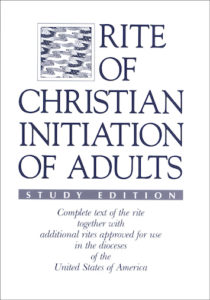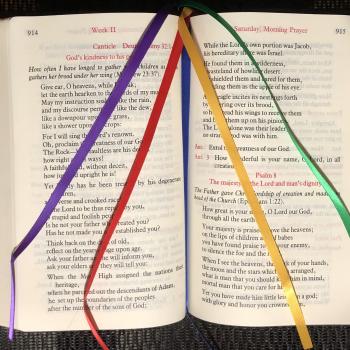The Rite of Christian Initiation of Adults — the Catholic process by which adults enter the Church — suggests that there are four stages or steps in the process of Christian initiation. These steps — evangelization, catechesis, initiation, and mystagogy — not only define the journey of general formation in the life of Christ (in other words, “becoming a Christian”) but they also give us insight into the process by which followers of Christ are called “deeper” into the contemplative or mystical life.

Okay, so words like evangelization, catechesis, initiation, and mystagogy are a mouthful. Let’s take a look at each one of these “steps” to an adult faith. And while I’m using specifically Catholic language of Christian initiation, I believe this way of understanding Christian formation would apply to other Christian traditions as well.
- Evangelization means simply “hearing the good news.” To be evangelized means to discover, for yourself, the possibilities of joy, wisdom, compassion, and inner transformation that await the person who chooses to follow Jesus Christ. Especially in our time, when so many misconceptions about Christianity abound in our culture, evangelization means unlearning some of the erroneous ideas about life in Christ (for example, that to be a Christian implies being judgmental or hostile to others) even as we embrace the joyful and promising message of unconditional Divine Love and its availability to us.
- Catechesis follows our first encounter with Divine Love: this is where we say “I want to learn more.” The emphasis here is on education: the student (“catechumen”) is given information and new insights to open his or her mind and heart to the splendor and promise of faith, of repentance (accepting the “higher mind” of Christ into our lives), of integration into the community of fellow Christians, and of service to the world at large. Catechesis is when we “learn the ropes,” so to speak. We are apprentices on this life-long journey of being formed as members of the Body of Christ.
- Initiation is the decisive moment, the point of no return, when we embrace the transformation that is offered to us in Christ. It is not a solitary act! Initiation into Christ, for adults, typically involves three sacramental rites, given to us by the church we are joining: Baptism, where we formally receive God’s cleansing us of our sin; Confirmation, where we say “Yes” to the indwelling of the Holy Spirit in our lives, and Communion, where we receive the Body and Blood of Christ. Notice the Trinitarian nature of initiation. The sacraments link us to God — and to one another — in the dazzling beauty of love.
- Mystagogy means, in the words of C. S. Lewis, “further up and further in.” We have received the good news, we’ve learned the ropes, we’ve been initiated into the new life. But our formation is never complete, not on this side of eternity. So the journey of ever-more-deeply giving ourselves to Christ continues. However, whereas Catechesis involved learning new ideas, new insights, new ways of seeing and thinking in response to the love of God, Mystagogy leads us to embrace the mystery of God — so it is more “heart” than “head,” more embodied, more experiential (in the humblest sense of the word), more reliant on allowing the indwelling Spirit to take the lead in our lives, encouraging and empowering us to love as Christ loves, to be Christ, to be Love, to be one with God (I Corinthians 6:17, Galatians 2:20, Colossians 1:27, II Peter 1:4).
It’s a wonderful process. Unfortunately, though, it seems that mystagogy often gets overlooked.
When I went through RCIA, we were basically turned loose after the Easter Vigil (the Rite of Initiation). The “mystagogy” step was more or less left for each person to figure out on his or her own. I recently discussed this with a friend who oversees the RCIA program in his parish, and he admitted that, in his church, about all they did for the new initiates was to encourage them to get involved in parish life, so they could “experience” it for themselves!
It’s not my purpose here to criticize catechists, who often put in many hours of dedicated service to help newcomers feel welcome and integrated into their church communities. I think mystagogy gets short shrift because of overall weaknesses in western Christian culture: we’re good at book-learning (that’s the “Catechesis” part), but we fumble when it comes to a more embodied way of formation: of discovering the inner process of being formed in Christ.

It seems to me that the season of “Mystagogy” would be a natural time for introducing new Christians to the regular practice of prayer (in all its many forms, but especially the Divine Office and silent prayer), lectio divina (the meditative reading of scripture), spiritual direction, Ignatian spirituality, the daily examen, making an annual retreat — and then engaging in the practice of reflection and discernment, to integrate all these spiritual practices into the more active side of Christian life, such as outreach ministries or parish work.
I understand that many churches simply don’t have the resources to provide this kind of intensive, almost one-on-one mentoring to their new members. Which is too bad, really. Priests and religious educators have admitted to me that far too many people who complete RCIA sooner or later drop out of active involvement with the church. Perhaps an effective process of mystagogy would help more of the new initiates to persevere in their ever-deepening relationship with (and formation in) Christ.
Mystagogy and Spiritual Formation
But my purpose in writing this blog post is not just to lament the imperfections of the RCIA process in Catholicism — but also to suggest that this fourfold process of formation applies not only to people joining the church for the first time but also to people who discern a call to become contemplative.
We are evangelized in contemplation when we first recognize in our heart a call for something deeper, a yearning for “more God” than words or ideas can satisfy. This stirring for something-more might come in response to a book we read, a conversation we have or an insight we receive in response to someone already on the contemplative path. Or the call may simply come from deep within us.
We are catechized in contemplation when we make the effort to learn more: we read books on contemplative prayer and related practices, we attend one or more retreats at a monastery or Jesuit center, we begin working with a spiritual director, we make the effort to begin praying the Divine Office. We’re beginners, in a time of apprenticeship marked by joy as we learn ways to respond to our call.
We are initiated into contemplation when we realize that we have made a non-negotiable commitment to the life of prayer, and that it is impacting how we relate to others. We pray daily, and encourage others to do so too. Perhaps we seek to become monastic oblates (or even to enter into religious life), or we discern a call to become a spiritual director. Each “initiation” is unique, but it marks us as contemplatives for life.
We embrace a contemplative mystagogy when we surrender to the recognition that growth in contemplation is a life-long journey (and beyond). We are always beginners, we are always apprentices. There is no limit to the depth of love into which we have been called. Union with God is not an idea to which we assent, but a way of living, being, knowing, to which we continually give ourselves. Life has become an ever-blossoming flower, a love affair with God that continually unfolds ever-new ways of receiving and sharing joy, wisdom, compassion, healing, and life. Further up and further in!
So where are you on your contemplative journey? Remembering that the map is not the territory (in other words, your unique adventure of responding to the love of God might look different), does this “four-movement” model speak to you? Is there something I’m missing? If you have any thoughts to share, please post them below.
Enjoy reading this blog?
Click here to become a patron.














